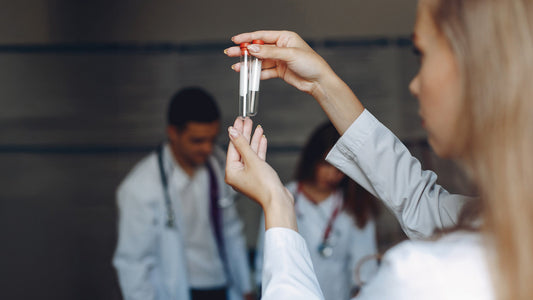You might be in perimenopause or menopause and experiencing changes like hot flashes, mood shifts, or brain fog. While estrogen often takes center stage in hormone conversations, it’s important to understand the foundational role of pregnenolone—and how it works with progesterone to support your well-being during this transitional time.
In my private practice, I’ve seen pregnenolone, especially when combined with progesterone, accomplish some pretty spectacular things for menopausal women.
In this article, we’ll explore what pregnenolone is, how it works with progesterone, and how they can support you through midlife changes.

What Is Pregnenolone?
Your body synthesizes pregnenolone from cholesterol and from there — it gets turned into cortisol, progesterone, estrogen, testosterone, and dehydroepiandrosterone (DHEA).
Pregnenolone is primarily produced in your adrenal glands. But pregnenolone synthesis also takes place in other tissues, including glial cells and neurons in your brain. (1)
Typically, as you age, your body makes less pregnenolone. Which is why pregnenolone supplementation during menopause makes sense for a lot of women.
What Are the Benefits of Pregnenolone and Progesterone for Midlife Women?
Pregnenolone supplements have caught on recently, for both men and women. Pregnenolone is particularly popular because not only does it provide the foundation for creating other hormones, but it also has a reputation for helping a variety of mental health disorders, including depression. (2,3)
Pregnenolone for women in menopause helps restore hormone balance by giving your body more of what it needs to make a little extra of your sex hormones. But when you combine it with progesterone, it creates an even more comprehensive approach to managing hormone balance.
Together, pregnenolone and progesterone play important roles in supporting mood, sleep, skin health, and overall hormonal rhythms during perimenopause and menopause.

How Pregnenolone and Progesterone Support Hormonal Changes in Menopause
Pregnenolone is a precursor to progesterone and other hormones, which means it plays a foundational role in the body's natural hormone production process.
Because pregnenolone can be transformed into a range of hormones, it may help support overall hormone rhythm. And progesterone is known to complement shifting estrogen levels, which can influence how you feel day to day.
Together, these ingredients may support midlife comfort, including skin hydration, mood steadiness, and a more restful evening routine.

Can Pregnenolone and Progesterone Help with Menopausal Mood Swings and Brain Fog?
Pregnenolone has been studied for its potential to support emotional steadiness and cognitive function. (4)
When used alongside progesterone—which interacts with GABA receptors known to promote a sense of calm—this combination may help support mental clarity and emotional wellness, especially during the ups and downs of midlife.

Do Progesterone and Pregnenolone Promote Better Sleep During Menopause?
Progesterone is known to support a relaxed state, which can be especially helpful in the evenings. Pregnenolone also contributes to a sense of calm through its role as a precursor to neurosteroids like allopregnanolone, which are associated with restful sleep cycles.
Together, these ingredients—when used topically as part of a cosmetic routine—may help promote more restful nighttime support. (5,6)

How Do These Hormones Relate to Bone Health in Midlife Women?
Progesterone is associated with bone density maintenance (7,8), and pregnenolone—through its conversion into other hormones—may complement bone wellness during midlife. Their combined presence in topical products may offer supportive benefits for overall aging wellness routines. (9)

How Progesterone and Pregnenolone Support Skin Appearance as You Age
Progesterone may help maintain the skin's natural elasticity and texture. (10) This is one of the reasons it's included in Balance Cream, which is designed to support maturing skin as part of your daily cosmetic routine.
Pregnenolone may also support glowing skin through its conversion into other hormones that benefit the skin, notably estrogen. (11) Together, they may support skin comfort, hydration, and a more radiant look over time.
Natural Ways to Support Pregnenolone Production
Pregnenolone levels tend to decline with age; there’s just no getting around that. But there are ways to help support your body's natural production.
One of the key factors is cholesterol—your body needs it to make pregnenolone. Including nutrient-dense sources of dietary fats like eggs, cheese, and sardines can be beneficial.

Lifestyle habits like quality sleep, regular exercise, and stress management can also encourage optimal hormone function.
Why Balance Cream Includes Pregnenolone and Progesterone
Balance Cream is a cosmetic formulation created by Dr. Anna, designed to support skin comfort and appearance during midlife. It includes both bioidentical progesterone and pregnenolone in a silky, hydrating base.
This cream is not a supplement, but a topical cosmetic product. Always consult your physician before using any hormone-containing topical products.
Does Pregnenolone Influence Estrogen Levels?
Pregnenolone is often referred to as a precursor hormone because it helps support the body's natural hormone pathways. It may be converted into estrogen, progesterone, and other steroid hormones as part of normal physiological processes (12). It’s at the top of the steroid hormone pyramid. That’s why we call it the mother hormone.
Because it supports a more gradual and balanced hormone shift, it is not typically associated with overstimulation. However, if you have or are at risk for estrogen-sensitive conditions, it’s important to consult with your healthcare provider before using any product that may influence hormonal balance.
How to Apply Balance Cream If You’re Perimenopausal
Count day 1 as the first day of your period. On day 14, begin applying one pump of Balance daily until day 28. This typically aligns with the luteal phase of your cycle.
Application Guidelines for Postmenopausal Use of Balance Cream
Postmenopausal women often apply one pump of Balance daily for 25 days, followed by a 5-day break. Alternatively, some choose to apply it 5–6 days per week with 1–2 rest days.
Each pump delivers a measured amount of cream containing bioidentical ingredients in a cosmetic base. Balance Cream contains approximately 20 mg of progesterone and 10 mg of pregnenolone per pump. This is for informational purposes only—application may vary depending on individual needs, and you should follow your healthcare provider’s guidance.
What’s the Best Time to Apply Balance Cream?
Dr. Anna recommends applying Balance Cream at night to align with your body’s natural rhythms and to support a restful evening routine.
What to Expect When Using Balance Cream Regularly
Some women notice changes within a few applications; others see results after 4–8 weeks. Like with any self-care practice, consistency matters.
Pregnenolone: The Most Misspelled Hormone on the Internet
Just for fun—here are some common misspellings:
Pregenelone
Pregnalone
Pregenolone
Pregnelone
Pregnenalone
Pregnanalone
Pragnenalone
So if you’re looking for pregnenolone and having trouble finding it, it could be because you’re spelling it wrong 😉 You’re not alone!
Final Thoughts: Hormonal Support in Midlife
Pregnenolone is such a fascinating hormone. And it plays such a crucial role in your mood, memory, sleep, bones, sleep, skin, and overall hormone balance during menopause.
Pregnenolone and progesterone are essential allies during perimenopause and menopause. Whether you're focusing on skin health, mood, or restful sleep, understanding their role can empower your wellness choices.
Balance Cream offers a cosmetic approach that integrates both of these ingredients to support your skin’s comfort and your self-care routine.
Related Articles
References
This content is for educational purposes only and is not intended to diagnose, treat, cure, or prevent any disease. Balance Cream is a cosmetic product.




